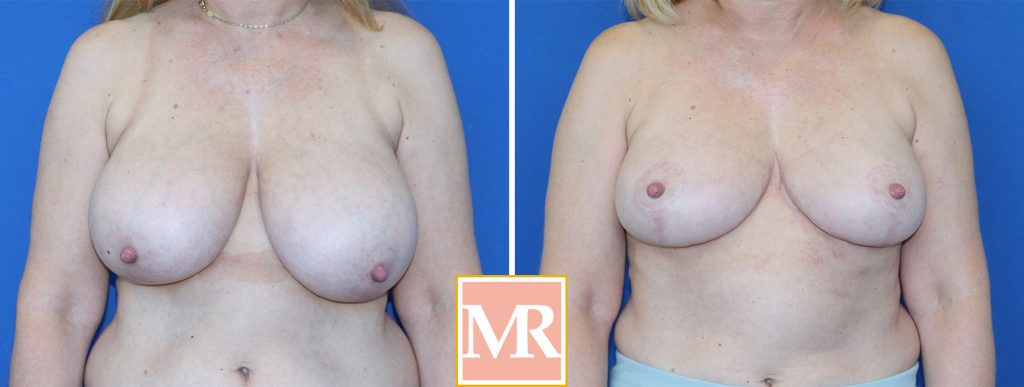Recovering from breast reduction surgery?
This week-by-week guide details what to expect during your breast reduction recovery week by week at each stage of your recovery.
From managing pain in the first 24 hours to resuming normal activities by week 6, Dr. Millicent Rovelo provides everything you need to know to navigate your recovery smoothly and effectively.

Book Your Appointment
With Dr. Rovelo, a top plastic surgeon in Beverly Hills
Key Takeaways
- The first 24 hours post-surgery are critical for pain management, rest, and following surgeon’s instructions to promote optimal healing.
- Gradual return to normal activities should begin in week 2, focusing on light movements and avoiding heavy lifting to ensure proper recovery.
- Regular follow-up appointments are essential for monitoring healing progress and addressing any concerns during the recovery process.
The First 24 Hours Post-Surgery
The first 24 hours after breast reduction surgery are crucial to setting the stage for a smooth recovery for breast reduction patients.
During this period:
- Pay close attention to pain management and mobility limitations.
- Expect some discomfort and swelling, which can be managed with prescribed pain relief.
- Strictly follow your surgeon’s post-op instructions.
- Avoid strenuous activities and heavy lifting to promote optimal healing. Understanding the breast reduction recovery timeline can help you prepare for the days ahead, ensuring a successful breast reduction recovery week and minimizing breast reduction scars. Additionally, proper care during breast surgery is essential for a successful outcome.
Prioritize rest during this initial phase:
- Allow your body to recover by taking it easy and resting as much as possible.
- Keep an eye on swelling.
- Manage discomfort with prescribed pain relief to aid your overall well-being.
The first 24 hours set the tone for your recovery week, so focus on rest and gentle care.
Days 2-3: Early Recovery Phase
As you transition into the early recovery phase, the focus remains on supporting your excess breast tissue healing and minimizing swelling.
Key recommendations during this phase include:
- Wearing a compression garment or surgical bra to reduce swelling and support the breasts.
- Avoiding strenuous activities.
- Avoiding heavy lifting to aid the healing process.
Light walking is recommended to enhance blood circulation and prevent blood clots.
These physical activities will also boost your energy levels and contribute to a smooth recovery.
Be patient with your body’s ability and give it the care it needs during this critical early recovery phase.
Week 1: Initial Healing Stage
In the first week, focus on:
- Rest and minimal physical activity to allow your body to heal and adjust to the changes.
- Monitoring your incision sites closely for any signs of infection.
- Following your surgeon’s instructions for changing dressings.
Proper wound care prevents complications and ensures smooth healing.
Effectively managing swelling during this stage can also greatly enhance your comfort.
Here are some ways to manage swelling:
- Use cold compresses to reduce swelling.
- Keep your upper body elevated whenever possible.
- Maintain a low-sodium diet to help minimize fluid retention and reduce swelling.
- Follow a balanced diet rich in vitamins and minerals to aid the healing process and boost overall well-being, reducing swelling.
The first week sets the foundation for a successful recovery.
Week 2: Gradual Return to Routine
By the second week post-surgery, you may begin to notice a significant improvement in neck pain and discomfort.
Start gradually returning to your normal routine, but with caution.
Resume most daily activities, but avoid heavy lifting and overexertion.
Taking it slow will ensure a smoother recovery as your body is still in the early stages of healing, especially in the week after surgery.
Lifting your arms should be done gently and within a comfortable range of motion.
Listen to your body and avoid pushing yourself too hard as you transition back to daily tasks.
Recovery is gradual, and giving yourself time and care will pay off in the long run.
Week 3: Increasing Comfort
In the third week, you’ll likely experience increasing comfort and a greater ability to resume normal activities.
Many feel well enough to return to work, drive, and perform most daily tasks comfortably.
However, it’s important to continue wearing compression garments to support your healing process.
Avoid activities that put pressure on your incision sites to ensure proper scar formation.
Scratching should also be avoided during this stage to facilitate smooth healing.
By this point, you may start to notice the results of your surgery, which can be incredibly motivating.
Week 4: Light Exercise and Side Sleeping
Week 4 marks an exciting milestone in your recovery process.
You can begin incorporating light exercises such as walking or gentle stretching into your routine.
These activities promote healing without undue strain on your body.
However, it’s important to avoid heavy lifting and rigorous exercise until you receive clearance from your healthcare provider.
Many can transition to side sleeping around this time, provided it feels comfortable.
Residual swelling may still be present but should decrease daily.
Embrace these changes as signs of progress and continue to care for your body with patience and gentleness.
Weeks 5-6: Returning to Normal Activities
By weeks 5-6, you’ll likely be ready to reintroduce more strenuous activities, but:
- Do so with caution and under the guidance of your healthcare provider.
- Increase physical activity gradually.
- Follow your doctor’s guidelines to ensure safety and avoid complications for six to eight weeks.
Most can comfortably return to regular daytime activities and work by this stage.
Driving is generally permissible, and your comfort should continue to improve.
Using scar creams during this phase can promote skin healing and reduce scar visibility, which is completely normal.
Avoid overexertion to prevent setbacks in your recovery.
Month 2 and Beyond: Full Recovery
Entering the second month post-surgery, you’re well on your way to full recovery.
While some residual swelling may persist, it will continue to decrease over the next few months.
Your breast size and shape may continue to adjust to your breast reduction chart, allowing you to fully appreciate the final results.
Regular check-ups with your healthcare provider during this phase monitor your recovery milestones and ensure proper healing of incisions.
These appointments address any concerns and provide guidance on maintaining your results.
Embrace this period as the culmination of your recovery journey and the start of a new chapter.

Tips for a Smooth Recovery
A smooth recovery requires adherence to several key practices.
Following your surgeon’s post-op instructions is crucial for minimizing complications and optimizing results.
This includes taking prescribed pain medication and antibiotics as directed, especially if you need surgery immediately.
Consistently wearing a compression garment provides support and aids in the healing process.
Maintaining a balanced diet rich in vitamins and minerals helps your body heal more efficiently and preserves the results of your surgery.
Scar care, including the use of scar creams, enhances the appearance of surgical scars over time.
Refrain from strenuous activities for the first 6 weeks.
Avoid heavy lifting to ensure a safe and smooth recovery.
What to Avoid During Recovery
Avoid certain activities and behaviors during the recovery period to prevent complications and ensure smooth healing.
Refrain from showering for the first 2 to 3 days after surgery to protect the incision sites.
Talk with your surgeon about when you can begin to shower.
Avoid soaking in baths, hot tubs, or pools for at least 6 weeks post-surgery.
During the initial recovery phase, follow these guidelines:
- Avoid lifting anything heavier than 5 pounds to prevent strain on healing tissues.
- Postpone intense cardiovascular activities and heavy lifting for at least four weeks post-surgery.
- Avoid tobacco use as it can hinder the healing process.
Managing Pain and Discomfort
Managing pain and discomfort is crucial to the recovery process.
Taking prescribed medications as directed during the initial phase alleviates severe pain and makes healing more comfortable.
By day 4, many switch to over-the-counter pain medications.
This transition indicates recovery progress and helps those who experience pain.
Methods and benefits related to pain management and recovery include:
- Ice packs can effectively reduce inflammation and manage pain.
- Lymphatic drainage massage can ease discomfort and promote healing during recovery.
- Managing pain effectively contributes to a smoother recovery and enhances overall well-being.
Importance of Follow-Up Appointments
Regular follow-up appointments with your healthcare provider are crucial for monitoring recovery and making necessary adjustments.
These visits allow your doctor to assess healing, ensure proper breast shape development, and address potential complications.
Follow-up appointments also provide an opportunity to remove stitches and discuss any recovery concerns.
Summary
The journey through breast reduction recovery is a gradual process that requires patience, care, and adherence to medical advice.
From the critical first 24 hours to the full recovery phase, each stage plays a vital role in achieving optimal results.
By following the outlined recovery timeline, managing pain effectively, and attending regular follow-up appointments, you can ensure a smooth and successful recovery.
Embrace this journey with confidence, knowing that each step brings you closer to enjoying the benefits of your breast reduction surgery.
Book an appointment with Dr. Rovelo today
Frequently Asked Questions
How long should I wear a compression garment after breast reduction surgery?
You should wear a compression garment or surgical bra for 6 weeks after breast reduction surgery to support healing and reduce swelling. This time frame is essential for optimal recovery.
When can I start exercising after breast reduction surgery?
You can start light exercises, like walking, around week 4 after breast reduction surgery, but avoid heavy lifting and rigorous activities until you receive clearance from your healthcare provider.
What should I avoid doing during the initial recovery phase?
During the initial recovery phase, it’s crucial to avoid showering for the first 2 to 3 days, as well as soaking in baths, hot tubs, or pools for at least 6 weeks. Additionally, refrain from lifting anything heavier than 5 pounds. Following these precautions will help ensure a smoother recovery.
How can I manage pain after breast reduction surgery?
To effectively manage pain after breast reduction surgery, take prescribed pain medications during the initial recovery, switch to over-the-counter options by day four, and apply ice packs to reduce pain and inflammation.
Why are follow-up appointments important after breast reduction surgery?
Follow-up appointments are vital for monitoring your recovery, addressing potential complications, and ensuring proper healing after breast reduction surgery. Staying on schedule with these visits can significantly impact your overall outcome and satisfaction.


